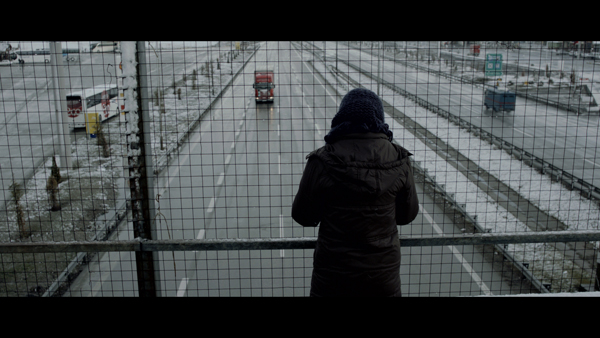
A scene from the Turkish film ARAF-SOMEWHERE IN BETWEEN (All photos: The Film Society of Lincoln Center)
At first glance, this year’s New York Film Festival is almost unrecognizable—a departure from its slimmer, more restrictive, and less glitzy programming of only a few years ago. What was once a small, curated festival has expanded, thanks to more screening space, but also perhaps due to an organizational objective to wedge itself as a permanent fixture on the awards circuit.
From time to time during its first 50 years, the festival has chosen a film that went on to awards glory—Chariots of Fire was the 1981 opening night film. Now it’s certainly on a roll. The award-winning The Artist, The Descendants, Hugo, and A Separation all screened last year. Only three years ago, just a single film went on to win one Oscar (The White Ribbon for best foreign language film). And shortly after the press screening of this year’s opening night film, Life of Pi, the Twittersphere went wild with predictions that Ang Lee’s new film would be a top Oscar contender. Even last year, the conversation at press screenings and in the lobby between screenings turned on which film was an awards magnet and less on what made a certain film stand out. And that was among critics. A festival devoted to recognizing films as the seventh art (without issuing awards to competing films) has become part of the horse race.
For the first time, the presenting Film Society of Lincoln Center will host a gala tribute during the festival, honoring actress Nicole Kidman in conjunction with the screening of the critically deflowered The Paperboy. With three of her films having played the festival, the still-in-her-prime Kidman is a logical choice for an onstage Q & A, but let’s hope the NYFF doesn’t get too carried away here in handing out award season tributes. (I walked right behind Kidman for the NYFF screening of Dogville—no, I wasn’t stalking her. That sort of casual accessibility to a major star has gone since the festival’s recent emphasis on red carpet photo ops.)
Luckily, the overall programming hasn’t been compromised. Despite all the changes, the NYFF still offers New Yorkers a valuable—and possibly the only—opportunity to see an abundance of movies that aren’t currently scheduled for an American release (though I’m sure that will change for many). Some of the most exceptional films from last year, Play and Sleeping Sickness, still haven’t yet found a U.S. distributor, so even a berth at the festival is no guarantee of an afterlife in theaters.
Most of these films are among the best this year, like the uplifting Fill the Void, one of the highlights of the Venice Film Festival, and the brooding and disturbing Araf-Somewhere in Between, which, had I seen it at its debut at Venice, would have considerably heightened my estimation of the films at that festival. This slowly mesmerizing film is dominated alternately by widescreen vistas of the flat, middle-of-nowhere Turkish rustbelt and piercing close-ups. In their late teens, Zehra and Olgun work in a roadside cafeteria along the highway between Istanbul and Ankara. Zehra’s the breadwinner in her conservative family, and she sometimes works 24-hour shifts. She longs to flee the sticks, but she has neither money nor escape plan. Olgun at least has a pie-in-the-sky dream, to appear on the game show Deal or No Deal. In fact, when he finally asks Zehra for a date, all he talks about is the show. They’re in limbo, each waiting for something to happen to change their lives.
It takes a wedding party sequence to loosen both Zehra and the film during a long take in which Zehra dances with a strutting and handsome older truck driver she has noticed at work: it’s the beginning of a shadowy, sensuous courtship. To describe him as taciturn is to put it mildly; he says nothing during the entire film.
Zehra is not really too different from Kim Novak’s small-town beauty in Picnic. Both see a chance of a new life with a good-looking drifter. In the last half-hour, writer/director Yesim Ustaoglu’s film takes a hard-hitting turn that I didn’t expect, which fluidly builds to a sobering conclusion, where Zehra and Olgun’s naiveté comes crumbling down. During one agonizing scene, I covered my eyes. (It’s tough going.)

Eddie Garcia and Princess in BWAKAW
Umberto D, Harry and Tonto please meet Bwakaw, another distinctive tale of an elderly loner and his pet. Until I saw this film, I thought Quill: The Life of a Guide Dog was the dog lovers’ film of the year. Now it has competition. Rene (in a vanity-free performance by Filipino star Eddie Garcia) waits for death. His home is cluttered with packed boxes that he has set aside as designated in his will, and he has already bought his coffin. He’s in his seventies, older, as someone mockingly puts it, “than the Filipino constitution.” He only showers tentative affection on a stray dog that he started feeding and that has stayed around, Bwakaw. The golden retriever mix trots everywhere by her master’s side, but not inside the house—she still must sleep outside. Rene, tough and stubborn, resists her whimpers.
When a childhood friend suggests he should try to be happy, Rene rejects the advice. He’s resigned to the fact that opportunities have passed him by—he came out as a gay man in his 60ss. He’s not exactly proud but matter-of-fact about his sexuality, and more than a little bitter: “When you’re all alone, alcohol is your only friend.” Remarkably, Garcia delivers this line without self-pity, but rather with remorse. For those who wanted more of Christopher Plummer’s belated coming-out in Beginners, this movie’s will especially appeal to you.
Director Jun Robles Lana layers his script with just enough detail for the viewer to infer an even richer character portrait in this terrific mix of black comedy and subtle sentimental drama. He also draws multi-dimensional performances from two flaming queens, cutting through the camp to find two sensitive (and ever patient) friends. And make way for Princess as Bwakaw, Garcia’s canine co-star. The director found the bomb-sniffing trained dog on YouTube, and she now even appears on her own soap opera.
Festival perennial Raúl Ruiz died last August during pre-production of Lines of Wellington. His longtime editor (and widow as well as a director with her own résumé) Valeria Sarmiento took over the mammoth undertaking with its huge historical scope—Napoleon’s invasion of Portugal and the struggle of the outnumbered Anglo/Portuguese to oust the French. Remarkably, many characters make a strong impression, though dozens of characters and multiple subplots crowd the film’s 151 minutes. There’s enough material here for a miniseries. (By far the most engaging storyline centers on the courtship of a young Irish widow by a down-to-earth Portuguese farmer-turned-sergeant.) Carlos Saboga’s script resists succumbing into a full-on love/revenge/war film, and instead takes a temperate tone, creating a richly detailed though oversized tapestry of ordinary people in wartime.
Tacit parallels link events to more recent European conflicts: images of roads clogged with refugees, scenes of a guerrilla attack and war crime atrocities, many inflicted on the civilian population. The painterly compositions, with a muted range of color, match the film’s tone, and were inspired by the little-known Swiss painter Henri Lévêque, depicted in the film (by Vincent Perez) as patiently trying to please a vain client, the Duke of Wellington. Among the international cast, John Malkovich struts as Wellington, but slaughters his British accent. In homage to Ruiz, his frequent collaborators Isabelle Huppert, Catherine Deneuve, and Michel Piccoli all appear together, though too briefly. Overall, it’s a film to admire, with moments here and there to fully embrace. Ruiz’s last film, Night Across the Street, will also screen at NYFF.
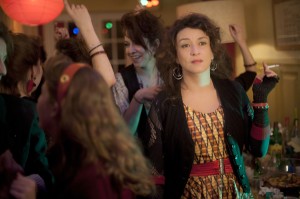
Noémie Lvovsky dancing away in CAMILLE REWINDS
In an interview this week in The Hollywood Reporter, the festival’s program director Richard Peña (who will be stepping down after this year) stated that the festival is “where you go to see the stuff that counts. We are kind of an elitist festival, but we really try to show what we think is the best.” That is certainly true with many of the “main slate” selection, but the understated French comedy Camille Rewinds, though diverting, doesn’t “count,” except as a contrast to the more somber or patience-demanding art-house fare.
It has a concept as high as they come: a 40-year-old struggling actress/alcoholic recently separated from her husband passes out at a New Year’s Eve party. She wakes up in 1985 back at home with her parents, who have actually long since deceased. Camille poses the same question that Kathleen Turner faced in Peggy Sue Got Married: if given a chance, would you change your past—if you could? In Camille’s case, will she allow herself fall in love again with the guy who will later dump her for a younger woman?
The sight of the 47-year-old actress (and the film’s director) Noémie Lvovsky in ’80s garb giggling and gossiping with her teenaged best friends is humorous for about a split second. The film otherwise plays the scenario straight and seriously. No one on screen bats an eye. Everyone sees Camille as a 15 year old, and Lvovsky resists turning the film into a giddy farce, even with all of the various plot complications. With the knowledge of a middle-aged woman, teenager Camille seduces a teenage boy, for example, while one of her teachers has a crush on her—is it the jail bait or the mature woman that the older man has fallen for? By the time the movie ends, the lessons learned don’t take much of a detour from what Peggy Sue discovered in her time travel.
However, Memories Look at Me is practically the perfect festival film, so delicate and seemingly simple that it needs such a forum to stand out. Debut director/writer Song Fang (who appeared in Flight of the Red Balloon) plays Fang, who returns to her parents’ home in Nanjing, and through intimate conversations, reestablishes her connection to the past. In this family affair, the director’s real-life family appears as its fictional on-screen counterpart. Not once will you catch them acting; watching Memories’s like listening to the secrets of this family’s history.
Though there was a written script, Fang allowed her cast to improvise. Often the camera feels like an eavesdropper, hovering outside a doorframe within the two-bedroom apartment (where most of the film takes place). When the camera holds on her mother describing—and reliving—her mother’s death, you don’t notice that minutes have gone by without an edit or camera movement. You’ve been drawn into the family’s past through the dialogue. You’ll see that story, and one of Fang’s uncle dying in a dilapidated hospital, in your own imagination. Kent Turner
More Films in the Main Slate:
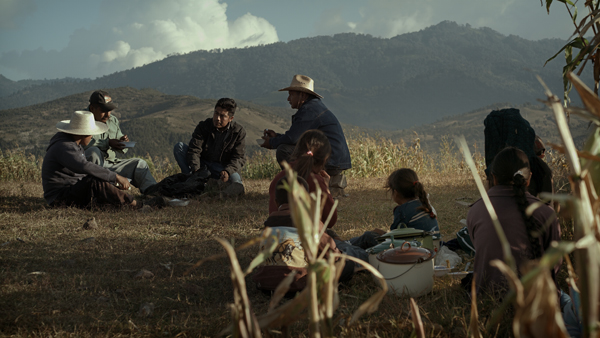
A scene from HERE AND THERE
Here and There doesn’t take any bold steps in formal experimentation, and freshman writer/director Antonio Méndez Esparza tells this modest but powerful story without fanfare. Each scene feels about as removed of false drama as is possible as Pedro—played by Pedro de los Santos Juárez—returns home to his Mexican village after a stint in the United States. Esparza keeps us engaged through a memorable progression of depictions of Pedro with his wife and two girls in their home and community. It’s a small window into the basics of their everyday lives, and experiencing it in a darkened theater produces a special feeling of intimacy with each character.
Pedro doesn’t have a story arc, per se. He has something much more realistic—a compelling life. His own interior drama is palpable as he yearns for his former life playing music with his band, though he enjoys the comforts of domesticity and familiarity back home after working endless shifts in a kitchen. Here and There, with chapter headings like “Aquí” and “Allá,” is a thoughtful examination about what these words actually mean, both physically and emotionally. This modest film was awarded the Grand Prize at Critics’ Week in May, perhaps heralding a less than epic year for Cannes and consequently the NYFF, celebrating its 50th season.
Now, hold up. There are big names this year. Brian De Palma arrives with Passion, a remake of Alain Corneau’s 2010 French hit Love Crime starring Rachel McAdams and Noomi Rapace. Is it good? Well… Let’s just say you have to see it to answer that. De Palma’s attempt to remake a film hardly two years old is an interesting choice, but knowing him, nothing should surprise us that much. This version exists somewhere between intense psychodrama and farce as we drift in and out of the dream consciousness of advertising creative director Isabelle (played very well by Rapace) as she spars with her manipulative boss, Christine (McAdams). Sex and office politics escalate between the two ostensible friends, and without fail (this is De Palma we’re talking about) there is bloody murder.
The Last Time I Saw Macao is about as far out a film as you’ll see in the NYFF main slate. Co-directed by Joao Rui Guerra da Mata and Joao Pedro Rodrigues (To Die Like a Man), it’s a complex sequence of documentary-style scenes of Macao, China. Often without anyone on screen, or at least without any featured characters or even foreground action, the story is created entirely through a man’s narrated voice-over and the voices of presumed characters not seen. The method of directing is unquestionably unique. It’s a heady journey through the über-urban spaces of Macao (the city with the highest population density in the world, so says the narrator), its hidden corners not seen by the casual visitor, and even the overgrown areas at the city’s outskirts. Meanwhile a story full of intrigue and murder unfolds at the edges and hidden corners of the frame.
An innocent but wary Portuguese man is summoned to Macao—a former Portuguese colony—by an old transvestite friend working as a dancer. She’s in trouble with some unseemly characters, but no matter how hard he tries, the man can never quite reach her. Simultaneously, we in the audience can never quite reach the story, as it comes to us through what would otherwise play as a comprehensive video journal of a sojourn in the Las Vegas of Southeast Asia. You never really know what’s going on in the dark places of the city around you, and this film is a rich exploration of that very idea.
If a narrative hints that what we see or hear right in front of us might not necessarily be true, then how can we know what the film actually means? Director Javier Rebollo asks us that question (and more) in The Dead Man and Being Happy, a sometimes farcical, sometimes hyper-intellectual take on the road movie wherein Santos, an aging would-be hit man with a terminal condition, fails to execute (get it?) his final job and takes off on a road trip across the Argentinean countryside. Along the way he meets another misfit, Erika, a middle-aged woman on the run for her own personal reasons. A dry narrator’s voice provides a (questionably) reliable, literal account of the plot as it happens. The high-minded Rebollo begrudgingly appeared in New York for the festival, but not without his Walter Benjamin reading material (so he says). There’s a vast depth of theory to glean from this film, and it’s not without a measure of entertainment value. Michael Lee
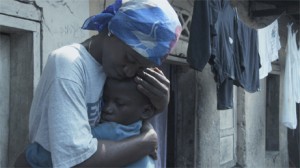
KINSHASA KIDS
Kinshasa Kids follows in the 1950’s tradition of socially conscious filmmaking pioneered by American Lionel Rogosin. Like Rogosin in South Africa (Come Back, Africa), Belgian director Marc-Henri Wajnberg similarly fashions the experiences of non-professional actors into a fictional story stylized like a documentary (here in the capital of the Democratic Republic of the Congo). He brings attention to the terrible travails of the more than 25,000 children living on the city’s streets, many of them kicked out of their families for being suspected as witches. In a bit thin and awkward story, the kids, outcast together in the city, find an uplifting outlet through music. They turn their gang into a band, with occasional help from a few charitable adults and even corrupt cops. Wajnberg explores the city’s diverse creativity that blooms amidst awful living conditions, and the performers includes church gospel, hip hop, Western classical orchestra, and the rhumba fusion of Papa Wemba, who makes an amusing cameo appearance. The lively youth and the soulful standout Rachel Mwanza, who subsequently starred in Kim Nguyen’s War Witch on the festival circuit this year, keep the audience’s heart strings thrumming beyond the slum tourism.
Leviathan is a meditative alternative to reality TV series like Deadliest Catch and its offshoots about commercial fishing—the deadliest occupation in the country, according to the National Institute for Occupational Safety and Health. Directors Lucien Castaing-Taylor and Verena Paravel aim for a visually sensual experience as they ship out from the New Bedford, MA, home port of Moby Dick, and exhaustingly follow behind the fishermen (we only occasionally see grizzled faces and hear a few clear words) on their around-the-clock grind amidst ever-changing weather conditions. With no narration, explanations, or interpretations, the beautiful views are captured from cameras adventurously crawling through the catch, dangling in the swells, venturing down in the hold, and up in the mast—warning: a viewer may get sea sick. Among the dizzying, confusing onslaught of black-and-white images, the best and most dramatic footage is from the fish-eye point of view. The future seafood not only faces entrapment in the fishermen’s huge nets, but also underwater dangers against bigger fish and, at the splashing waterline, from the noisy, ever-circling birds.
While this very abstract portrait is in the festival’s Main Slate, another audience-be-damned selection that builds up very slowly through a compilation of sequences is Jeff Preiss’s Stop, in the “Views from the Avant-Garde” section. Preiss pares down 15 years of 16 mm home movies of his family’s travels around the world and their holiday gatherings into two interminable hours, but the passing of time allows the audience to gradually and intimately watch the child change on screen from adorable toddler to independent teenager with a highly personal take on gender. This (eventually) involving exposé of the chasm between what we see in a Kodak moment and what the subject privately feels should be welcomed in LGBT film festivals. Nora Lee Mandel
Last updated on October 24, 2012

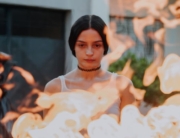














Leave A Comment